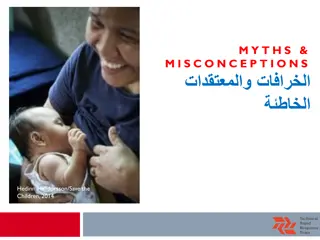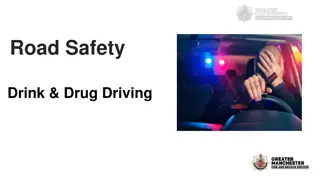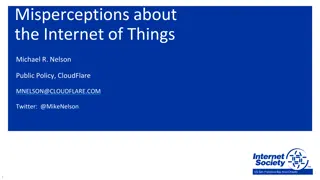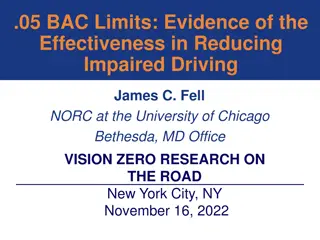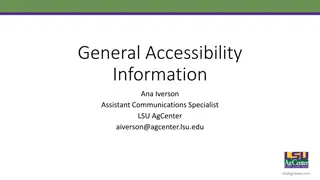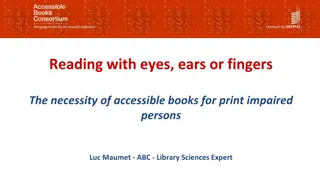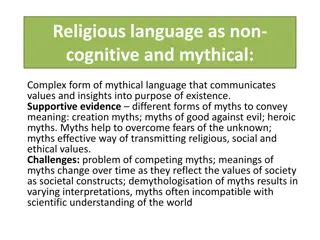Debunking Myths of Impaired Driving
Much of what we believe about drinking and alcohol are based on myths and misconceptions. This content presents common myths such as the alcohol content in beer compared to hard liquor, the misconception about daily drinking among alcoholics, the ineffective use of coffee to sober up a drunk person, and the dangerous practice of letting someone "sleep off" alcohol poisoning. Learn the truth about these myths to stay safe and informed.
Download Presentation

Please find below an Image/Link to download the presentation.
The content on the website is provided AS IS for your information and personal use only. It may not be sold, licensed, or shared on other websites without obtaining consent from the author.If you encounter any issues during the download, it is possible that the publisher has removed the file from their server.
You are allowed to download the files provided on this website for personal or commercial use, subject to the condition that they are used lawfully. All files are the property of their respective owners.
The content on the website is provided AS IS for your information and personal use only. It may not be sold, licensed, or shared on other websites without obtaining consent from the author.
E N D
Presentation Transcript
Myths of Impaired Driving
Presented by GEORGE GEISLER Drug Recognition Expert PA DUI Association Law Enforcement Services Harrisburg, PA 717-238-4354 ggeisler@padui.org
Myths of Impaired Driving Much of what we learn about drinking and alcohol comes from what we hear from other people. But how much of it is true? The fact is that there are many myths and misconceptions out there that you should be aware of:
MYTH: Beer doesnt have as much alcohol as hard liquor. A 12-ounce bottle of beer has the same amount of alcohol as a standard shot (ounce and a quarter) of 80-proof liquor (either straight or in a mixed drink) or 4 ounces of wine.
MYTH: Alcoholics drink every day. The measure of alcoholism is not when or how often one drinks, but whether or not one can control the drinking once it begins. Some alcoholics drink daily, others may only drink on weekends or in binges which could occur weeks, months or even years apart. Learn how to talk to a friend who may be drinking too much.
MYTH: Coffee will sober up a drunk. Your friend is feeling pretty drunk and wants to sober up fast, so he downs a couple cups of coffee. The coffee may make him a more wide-awake drunk, but he s still just as drunk. Coffee is not a cure for drunkenness same for cold showers or exercise. The only thing that sobers you up is time. In general, it takes about one hour for your body to eliminate one standard size drink.
MYTH: If your friend passes out from drinking, you should put them to bed and allow them to "sleep it off." The amount of alcohol it takes to make you pass out is dangerously close to the amount it takes to kill you. If a friend passes out from drinking, the last thing you want to do is drag him or her into a bedroom away from everyone else. If a friend passes out, keep a close eye on him or her, making sure his or her breathing and heart rate is normal. If there is any reason for concern, get medical attention immediately you may save your friend s life.
MYTH: Blacking out and passing out are the same thing. Blacking out is a loss of memory like not being able to remember the night before because you had so much to drink. Passing out is not being able to be awakened. Either is a sign that your friend might have a serious drinking problem.
MYTH: Your friend is OK to drive if they ve only had a few drinks. Too many good friends are lost to drinking and driving accidents. In fact, about half of all fatal traffic accidents among 18-24 year olds involve alcohol. The safest choice is always to not drink and drive, and to make sure your friends don t get behind the wheel after drinking. The amount of alcohol you can drink before your driving ability is impaired is different for everyone and depends on a lot of different factors, like how fast you drink, your weight, your gender and how much food you have in your stomach. It s better to play it safe by having a designated driver or a plan to spend the night.
MYTH: Hangovers are caused by mixing different kinds of drinks. Hangovers are caused by the amount of alcohol you drink, and how fast you drink it not by types of alcohol. Drinking alcohol can dehydrate your body, irritate the lining of your stomach and cause blood sugar levels to drop, all of which contribute to hangovers. Get tips on preventing hangovers.
MYTH: Someone who has had too much to drink will look drunk. Just because your friends aren t slurring their words and staggering around doesn t mean they are not drunk. Judgment is the first thing affected when someone has been drinking coordination and motor skills are second and third. In other words, your friends might be making decisions they ll regret as the result of being impaired, but never appear to be drunk.
MYTH: Alcohol is a stimulant. Alcohol is a depressant it sedates the central nervous system. One of the first areas of the brain to be affected is the cerebral cortex, which controls judgment, self-control and inhibitions. The depression on this part of the brain may result in excitable behavior, as inhibitions are lost.
MYTH : Drinking milk or eating greasy foods before drinking will coat your stomach and keep you from getting drunk or sick. The stomach cannot be "coated" to prevent alcohol absorption. However, it is a good idea to encourage your friends to eat foods rich in carbohydrates and proteins before consuming alcohol, because this helps reduce the amount of alcohol that is absorbed directly into the blood stream through the stomach.
MYTH: The best cure for a hangover is the hair of the dog that bit you. Many people think if they have a hangover, a shot of alcohol will make them feel better. This is sort of like giving water to a drowning person. The problem is the body is trying to recover from too much alcohol why would you add to that?
MYTH: Alcohol affects you the same way every time you drink. Not really. Your reactions vary depending on different circumstances how you feel mentally and emotionally, your expectations, tolerance, if you re on medications, etc.
MYTH: Women can drink just as much as men of the same size. Women lack an enzyme that helps break down alcohol, so they cannot drink as much as men, even if they are the same size, which most are not. This is why there are different Blood Alcohol Concentration (BAC) charts for men and women.
Myth: Sucking on pennies will lower a person s BAC reading. Sucking on pennies or other copper has no effect on alcohol breath tester BAC results. Don t be a sucker... it makes no cents!
Myth: Alcohol on the breath is a reliable sign of alcohol consumption and intoxication. Alcohol is actually odorless.... it has no smell. What people perceive as alcohol on the breath is actually the odor of things commonly found in alcoholic beverages. The breath of a person who drinks a non-alcoholic beer will smell the same as that of a person who has consumed an alcoholic beer. Research using experienced law enforcement officers has found that odor strength estimates are unrelated to blood alcohol concentration (BAC), which ranged in the experiment from zero to .13 (almost twice the legal limit for driving). The estimates made by the officers were no more accurate than random guesses. The researchers concluded that estimates of alcohol on the breath are unreliable, they only show a person has been drinking.
Myth: People who abstain from alcohol are "alcohol-free" and can t be arrested for DUI. The human body produces its own supply of alcohol naturally on a continuous basis, 24 hours a day, seven days a week. It s called endogenous ethanol production. Therefore, we always have alcohol in our bodies, however not enough to give a reading or become legally intoxicated and arrested for DUI.
Myth: A Breathalyzer will clear from suspicion Those diabetics suffering hypoglycemia, whose slurred speech, disorientation, staggering, drowsiness, poor motor control, and flushed face cause them to fail field sobriety tests. Hypoglycemia causes acetone in the breath, which the Breathalyzer will record as alcohol on the breath. Unfortunately, about one of seven drivers is diabetic and at risk of false arrest and conviction for DUI/DWI. That s why other tests are done to rule that cause out.
Myth: Field sobriety tests, are not being based on scientific principles, to accurately identify intoxicated drivers. NHTSA research began in 1975 in California with three final reports being published: SFST California: 1977 (lab study only) California: 1981 (lab/field study) Maryland, Washington, DC, Virginia, North Carolina: 1983 (field study only)
Myth: Field sobriety tests, are not being based on scientific principles, to accurately identify intoxicated drivers. Laboratory Test Data Results on SFST Tests HGN by itself was 77% accurate Walk and Turn was 68% accurate One Leg Stand was 65% accurate All three tests give an officer a 92% reliably the person is impaired
Myth: Breathalyzers and other breath testers are accurate. Even in the absence of any of these common problems and under ideal conditions, alcohol breath testers have varying degrees of accuracy as does all chemical testing protocols. However, FORENSIC Blood testing and breath test units are accurate 60 70% of DUI drivers arrest today are under the influence of drugs. ( the use of DRE s and blood tests) The only way drugs can be detected accurately is through blood testing.
MYTH: It's always better to refuse to provide breath or blood when suspected of a DUI. Refusal of requests to do field sobriety test or to submit to a legal blood or breath test is admissible in court as consciousness of guilt. If you have nothing to hide, why would you not do what is asked of you by the officer? When it comes time for your case to be adjudicated, failure to cooperate with the officer may result in your not being able to make a deal with the prosecutor for a less harsh sentence. Refusal of legal testing results is license suspension of at least one year, automatically.
MYTH: If you pass all field sobriety tests, the police will release you. The police understand that field sobriety tests are not always accurate. Therefore, if they think you are driving while under the influence, they can request further testing. Furthermore, you can refuse to do field sobriety tests and still be arrested and successfully prosecuted for impaired driving.
MYTH: If you just drink a small amount, you don't have to worry about getting behind the wheel. Any amount of alcohol can affect your judgment on the road. Alcohol influences each person differently, depending on factors such as body weight and the regularity of this type of consumption. It's always ideal to refrain from driving immediately after drinking any alcoholic beverages, however small.
MYTH: Once you're arrested for drunk driving, it's fine to be belligerent and argumentative in the back of the police car. This behavior can't be held against you. Police officers are constantly observing the behavior of alleged DUI offenders. Additionally, there is a good chance you are being recorded the minute you step into a police car. This evidence could be seen by a jury in a DUI case and may lead to aggravated or additional charges.
MYTH: Its only the young and inexperienced drivers who are affected by alcohol It is true that being an inexperienced, possibly younger, driver will increase the chances of having a wreck when alcohol consumption is involved, but by no means are young and or inexperienced drivers the only ones incapable of drinking and driving. Drinking alcohol, no matter how old you are or how long you have been driving, will affect your cognitive state of mind and debilitate your senses needed to safely drive a vehicle. Don t chance your safety based on age, sex, weight, driving experience or hair color when it comes to drinking and driving. If you drink, make the choice not to drive until your blood alcohol concentration (B.A.C) levels have dropped.
MYTH: I can still be in control after drinking Maybe you have driven after drinking 101 times before and feel convinced you are still in control after drinking. Even though you may not have a staggering walk or be running into walls, the fact is that after only one beer impairment begins to set in and slows your reaction time. Alcohol affects not only vision and coordination but also alters your attention span, reaction time, judgment and not to mention the ability to multi- task with all vital parts in operating a vehicle and all external stimuli.
MYTH: If I have to, I can sober up quickly No matter how much you allow yourself to feel control has been regained after drinking alcohol, simply by will, is a common misconception. From the very first drink, judgment begins to impair, reflexes relax and slow down. Drinking alcohol is what it is and only time without drinking can flush your system, allowing you to regain the senses needed to drive safely. Don t drink or use drugs and drive, just wait a little bit. Use the facts to be sure you are not technically "drinking and driving."
MYTH: I just need to eat and I ll be o.k. to drive Being that it is never a good idea to drink on an empty stomach, having eaten with your drink(s) is still not a sure-proof defense against impaired driving. In fact, the only absolute way to be surly be safe is time. It takes about 6 hours for the body to completely purge alcohol when a B.A.C level is at the legal limit of .08. Food while drinking is good but not a fail-safe when it comes to drunk driving statistics.
MYTH: Bigger people are more equipped to handle alcohol so they can drink and still be able to drive safely Granted, a person s physical stature does play a role in determining the rate at which alcohol symptoms take effect. However, one must also take into consideration an individual s metabolism, when the last time that person ate and how much sleep they got leading up to drinking. These complex calculations could determine the possibility of risking one or more person s life when agreeing they are alright to get behind the wheel of a vehicle.
MYTH: As long as I splash cold water on my face and roll down the car window for fresh air, I ll be fine Waiting it out is the only option to be "fine" to drive safely after drinking. Splashing your face with cold water and rolling down the car window feels good and may give you a sense of revitalization, but the fact is that you drank alcohol and put alcohol into your body. Neither cold water nor blowing wind will get it out of your system and prepare you to drive safely. Don t be hasty when it comes to drinking and driving, drunk driving accidents are no laughing matter. The impaired person behind the wheel of a vehicle has the same probability of crashing with his window down and he does with it up.
MYTH: Im only driving a few blocks to get home FACT: The majority of car accidents happen close to home, typically between 2 and 5 miles close to home. Statistics show that only 1% of car accidents took place more than 50 miles away from the driver s home. Those are pretty tough odds to beat especially after driving.
MYTH: I wont get caught. Law enforcement has increased impaired driving enforcement activities in recent years and the penalties for driving under the influence have become even harsher. New legislation also gives police the ability to test drivers they believe to be under the influence, for drug/alcohol impairment and charge those who do not comply, to supply a mandatory saliva, blood or urine sample. Depending on the severity of the drunk driving or drug influenced situation, consequences could include a 24 stay in the local jail, vehicle impound, fines and even sentencing to longer jail-time. If the drunk driving case was bad enough, a rehabilitation program and installed vehicle ignition interlock device may be required
Myth: I took the State administered breath test and blew under 0.08, so I can't be charged with a DUI. The Commonwealth of Pennsylvania provides for prosecution of a driver for Driving Under the Influence even when the breath results show a result of less than the legal limit of 0.08 so long as the State can show the driver was a "less safe" driver due to the consumption of alcohol than he/she would have been without consuming any alcohol. The State proves this by showing the judge and/or jury driving manifestations and performance on Field Sobriety Evaluations. Minors (under 21) .020 BAC gets you arrested for DUI, that s one drink in most cases. .040 if driving a CDL vehicle / .020 for school bus
Myth: You can only get a DUI if your impaired by alcohol: You can be convicted of a DUI if your impaired by any alcohol or drug (legal or illegal) to the slightest degree. Further, when it comes to DUI with drugs the State only has to prove that you have the drug metabolite in your system at the time of driving. This means a person could be sober at the time of driving, but if an officer pulls that person over and thinks they have showed signs and symptoms of drug use the officer could arrest them for DUI. In this scenario if blood is taken and drug metabolite from weeks ago is still in the blood stream then that person could be convicted of DUI.
Myth: I was stopped on private property so cannot be convicted of a DWI. This is simply not true. You can be convicted of DWI regardless of where you operated a vehicle as long as it is on a highway , roadway or trafficway . A trafficway is a roadway of which any part thereof is usually and customarily open to the public.
Myth: I wasnt driving; I was parked The law says Drive, operate or be in actual physical control of a vehicle. If your vehicle is on you may be convicted of DWI regardless of whether it was actually in motion at the time the police approached you.
Myth: My last drunk driving conviction was more than 10 years ago. I won't face any increased penalties." Judges go beyond the ten-year look-back period when determining sentences in DUI cases. The reality is that a drunk driving conviction remains on your record forever and probably will be used against you by the judge determining your sentence on a subsequent DUI conviction occurring several years after your last conviction.




